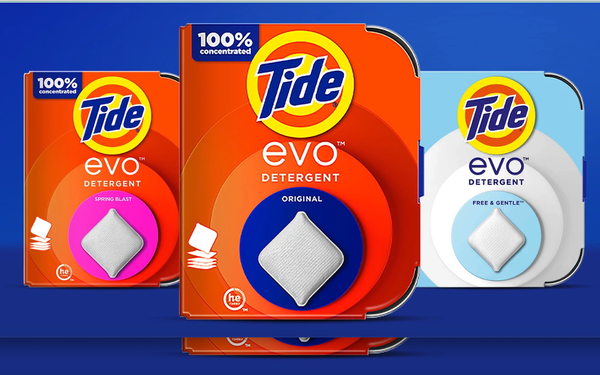CFO: P&G Aims To Build Growth With Product Innovation 10/27/2025 – MediaPost

Procter & Gamble Q1 FY2026 Report: Innovation and Sustainable Development Goals
Strategic Focus on Sustainable Innovation in Core Categories
In its Q1 FY2026 earnings report, Procter & Gamble (P&G) outlined a strategic pivot towards innovation-led growth in its underperforming fabric and baby care divisions. CFO Andre Schulten emphasized the company’s commitment to “create sustainable growth” by driving product superiority. This approach aligns with several Sustainable Development Goals (SDGs) by focusing on long-term value creation over short-term promotional activities.
Fabric Care Division: Aligning with SDG 12 (Responsible Consumption and Production)
The fabric care division is introducing significant product innovations designed to meet consumer demand for both efficacy and environmental responsibility, directly supporting the targets of SDG 12.
- Eco-Friendly Product Development: The upcoming national launch of Tide EVO, an eco-friendly detergent, represents a major step towards sustainable product offerings. Its “Free and Gentle” iteration caters to consumer well-being (SDG 3).
- Sustainable Packaging: Tide EVO is packaged in a fully recyclable container, contributing to the reduction of waste and the promotion of a circular economy.
- Market Validation: In test markets, Tide EVO has proven “highly incremental to category growth,” indicating strong consumer and retailer demand for products that support responsible consumption.
- Enhanced Formulation: The core Tide liquid detergent has received its “biggest upgrade in 20 years,” featuring a boosted formula for superior cleaning performance, reflecting a commitment to innovation (SDG 9).
Baby Care Division: Enhancing Consumer Well-being (SDG 3)
P&G is upgrading its Pampers portfolio to drive consumer trial and satisfaction, reinforcing its commitment to the health and well-being of infants, a core tenet of SDG 3.
- Upgraded versions of Pampers Easy Ups.
- Enhanced formulations for Swaddlers and Cruisers.
- The first phase of a restage for the mid-tier Pampers Baby Dry line.
Corporate Strategy for Long-Term Sustainable Growth (SDG 8 & SDG 9)
P&G’s overarching strategy integrates principles of sustainable economic growth, innovation, and responsible market practices.
- Innovation as a Growth Driver (SDG 9): The company is prioritizing innovation to foster sustainable industrialization and build resilient infrastructure within its operations. The goal is to achieve market leadership through superior product offerings that are meaningful to both consumers and retailers.
- Adapting to Consumption Patterns (SDG 12): P&G acknowledges the consumer shift towards larger pack sizes in club stores and online channels. The company is working with retail partners to optimize its value offerings, which can contribute to reducing packaging waste per unit of product.
- Organizational Restructuring for Efficiency (SDG 8): P&G plans to reduce 7,000 non-manufacturing roles in fiscal years 2026 and 2027. This strategic restructuring aims to create smaller, digitally-enabled teams to improve productivity and focus on consumer-centric brand-building, thereby promoting sustained and inclusive economic growth.
Analysis of Sustainable Development Goals in the Article
1. Which SDGs are addressed or connected to the issues highlighted in the article?
-
SDG 8: Decent Work and Economic Growth
This goal is connected through the company’s plan to cut 7,000 non-manufacturing jobs to improve efficiency and create smaller, more focused teams. This action directly impacts employment, a core component of SDG 8.
-
SDG 9: Industry, Innovation, and Infrastructure
The article heavily emphasizes P&G’s strategy of driving growth through innovation. The launch of new products like the “boosted formula” Tide and Tide EVO, described as the “biggest upgrade to liquid detergent in 20 years,” directly relates to fostering innovation within the industry.
-
SDG 12: Responsible Consumption and Production
This goal is addressed through the introduction of Tide EVO, which is explicitly described as an “eco-friendly product” packaged in a “fully recyclable container.” This highlights a shift towards more sustainable production patterns and offering consumers more responsible choices.
2. What specific targets under those SDGs can be identified based on the article’s content?
-
SDG 8: Decent Work and Economic Growth
- Target 8.2: Achieve higher levels of economic productivity through diversification, technological upgrading and innovation. P&G’s plan to restructure its workforce by creating “smaller teams that are better set up via fully digitally enabled data access and analysis” is an attempt to increase economic productivity through technological and structural upgrades.
- Target 8.5: By 2030, achieve full and productive employment and decent work for all. The article highlights a challenge to this target by stating P&G’s plan to “cut 7,000 non-manufacturing roles,” which represents a significant reduction in employment within the company.
-
SDG 9: Industry, Innovation, and Infrastructure
- Target 9.5: Enhance scientific research, upgrade the technological capabilities of industrial sectors… encouraging innovation. The article’s focus on P&G’s efforts to “drive superiority through innovation” and the launch of products with “advanced perfume innovation” and new formulas directly aligns with this target of upgrading technological capabilities and fostering innovation.
-
SDG 12: Responsible Consumption and Production
- Target 12.5: By 2030, substantially reduce waste generation through prevention, reduction, recycling and reuse. The introduction of Tide EVO in a “fully recyclable container” is a direct action aimed at reducing waste generation by designing products for recycling, thus contributing to this target.
3. Are there any indicators mentioned or implied in the article that can be used to measure progress towards the identified targets?
-
For Target 8.5 (Employment)
- Indicator (Mentioned): The number of jobs eliminated. The article provides a specific figure: “cut 7,000 non-manufacturing roles.” This is a direct, quantifiable measure of the impact on employment.
-
For Target 9.5 (Innovation)
- Indicator (Implied): The rate of new product introduction and upgrades. The article mentions the launch of a “boosted formula” for Tide, a new product line “Tide EVO,” and “upgraded versions of Pampers Easy Ups, Swaddlers, Cruisers.” The frequency and significance of these innovations serve as an implied indicator of progress.
-
For Target 12.5 (Waste Reduction/Recycling)
- Indicator (Mentioned): The availability of products with sustainable packaging. The article explicitly mentions the “fully recyclable container” for Tide EVO.
- Indicator (Implied): Consumer and retailer adoption of sustainable products. The article notes that for Tide EVO, “retailer demand… [is] well above initial expectations” and it has been “highly incremental to category growth” in test markets. This demand can be used as a proxy indicator for the market’s shift towards more sustainable products.
4. Table of SDGs, Targets, and Indicators
| SDGs | Targets | Indicators |
|---|---|---|
| SDG 8: Decent Work and Economic Growth | 8.2: Achieve higher levels of economic productivity through… technological upgrading and innovation.
8.5: Achieve full and productive employment. |
– Restructuring to create “smaller teams that are better set up via fully digitally enabled data access and analysis” (Implied).
– Number of jobs cut: “7,000 non-manufacturing roles” (Mentioned). |
| SDG 9: Industry, Innovation, and Infrastructure | 9.5: Enhance scientific research, upgrade the technological capabilities of industrial sectors… encouraging innovation. | – Introduction of new products and formulas like the “boosted formula” Tide and “Tide EVO” (Implied).
– Description of product as the “biggest upgrade to liquid detergent in 20 years” (Implied). |
| SDG 12: Responsible Consumption and Production | 12.5: Substantially reduce waste generation through… recycling. | – Availability of products in a “fully recyclable container” (Mentioned).
– Market performance of eco-friendly products: “highly incremental to category growth” (Implied). – Retailer demand for sustainable products: “well above initial expectations” (Implied). |
Source: mediapost.com
What is Your Reaction?
 Like
0
Like
0
 Dislike
0
Dislike
0
 Love
0
Love
0
 Funny
0
Funny
0
 Angry
0
Angry
0
 Sad
0
Sad
0
 Wow
0
Wow
0


















































.jpg.webp?itok=0ZsAnae9#)



/environment-climate-change-and-health-(ech)/water-sanitation-hygiene-and-health-(wsh)/landfill-tuvalu-36092.tmb-1200v.jpg?sfvrsn=5c21fe40_1#)




















